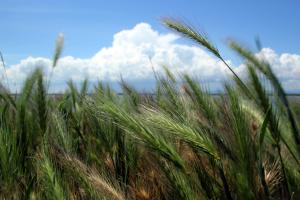 I started this series of articles about the Sea of Galilee with:
I started this series of articles about the Sea of Galilee with:
-Sea Of Galilee -#1: Galilee Boat - this article is about a prehistoric boat found in the vicinity of the Sea of Galilee many consider to possibly be the boat Jesus and his disciples used.
Sea Of Galilee -#2: Names - this article discussed the several names the Sea of Galilee has been called over the years and the reasons for them.
Sea Of Galilee -#3: Ohalo
Any look at the Sea of Galilee during Prehistoric times would be absolutely remiss without considering the two excavations of Ohalo. Why? Because in 1989 a significant find was discovered under the water at the south end of the Sea of Galilee.
What is the significance of this excavation? The remains of this hunter-gatherer location are considered to be one of the first permanent settlements of humans in the history of the world, as well as a portion of the Cradle of Civilization.
Ohalo predates the Neolithic Revolution that occurred somewhere around 10,000 to 8,000 BCE. The Neolithic Revolution was the first wide-scale transition of several human cultures from a hunter-gatherer lifestyle to an agricultural settlement making large populations possible.
Nahal Ein Gev is another significantly important prehistoric village in the Sea of Galilee region. Located 1.2 miles east of the Sea of Galilee, Nahal Ein Gev contains a Late Natufian Period village. This village, from about 12,000 BCE, is found in the Ein Gev stream that flows west into the Sea of Galilee.
The Natufian culture dates to around 15,000 to 11,500 years ago and is unique because the culture supported a semi-sedentary population prior to the introduction of agriculture. This evidence helps prove humans resided around the Sea of Galilee during Prehistoric times.
The 1.2 square miles excavated portion of Ohalo, on the southwest shore of the Sea of Galilee, dates to the Last Glacial Maximum. This was the most recent time during the Last Glacial Period ice sheets were at their largest extent. It is speculated more of Ohalo remains under the Sea of Galilee and can not be excavated unless the water level lowers sufficiently enough to do so.
Ohalo's age has been dated to between 14,000 to 33,000 years ago. Radiocarbon dating places Ohalo's age closer to 23,000 years ago at the junction of the Upper Paleolithic (Late Stone Age) and Epipaleolithic Period. Before the Neolithic Period (when farming was first developed).
began. In other words, humans have lived around the Sea of Galilee for a very long time.
Ohalo is noted for the world's oldest brushwood dwellings (homes made out of branches) and the world's earliest small-scale plant cultivation, about 11,000 years before agriculture started. Ohalo possessed exceedingly rare cereal grains and fruits. These were preserved in anaerobic conditions under silt and water. Anaerobic conditions occur when the disappearance of oxygen is larger than its production for photosynthesis.
Six charcoal rings where these dwellings stood have been unearthed. Oval in shape, they ranged from 9 to 16 feet long. Uniqely, these dwellings contained hearths.
A grave, and probable refuse dump, were discovered at Ohalo. So were animal bones, flints, and various artifacts. Moreover, there have been a combined hundreds of species of birds, fish, large animals, and vegetables found there.
It is thought the same time humans settled at Ohalo, the Sea of Galilee was newly formed. Possibly only a few generations after being settled, Ohalo burned to the ground. Whether this fire began accidently, or was intentionally set, remains unknown.
At the same time Ohalo burned, the water level of the Sea of Galilee rose and buried the site. This sealed Ohalo and protected the locale until it was discovered. Ohalo was found when an extended drought dropped the water level in the Sea of Galilee 29 feet.
One of the major finds at Ohalo is known as Hut 1. This hut provided 90,000 seeds of barley, fruits, brome grains, millet grass grains, and rubus berries. Other discoveries in Hut 1 have been a trapezodial grinding stone, bladelets from flints, 132 stone tools, modified stone flakes, and sickles for harvesting cereals
Look for Sea Of Galiee -#4: Via Maris.
During the Early Roman, Hellenistic, and Judean Occupations of Israel, the Via Maris passed by the Sea of Galilee and was one of the most important trade routes between Egypt and Anatolia.
Author Notes
green up, by julia Eye, selected to complement my article.
So, thanks julia Eye, for the use of your picture. It goes so nicely with my article.
|
|



